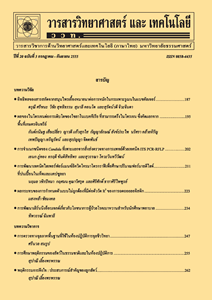การทดสอบรากหนึ่งหน่วยโดยอิงตัวประมาณสมมาตรถ่วงน้ำหนักแบบปรับปรุง
Main Article Content
บทคัดย่อ
บทคัดย่อ
การวิจัยครั้งนี้มีวัตถุประสงค์เพื่อสร้างตัวทดสอบรากหนึ่งหน่วยโดยอิงตัวประมาณสมมาตรถ่วงน้ำหนักแบบปรับปรุง สร้างตารางค่าวิกฤตของตัวทดสอบรากหนึ่งหน่วยที่สร้างขึ้น และเปรียบเทียบความสามารถในการควบคุมความน่าจะเป็นของความคลาดเคลื่อนประเภทที่ 1 และกำลังการทดสอบของตัวทดสอบรากหนึ่งหน่วย 4 ตัว ได้แก่ ตัวทดสอบรากหนึ่งหน่วยโดยอิงตัวประมาณสมมาตรถ่วงน้ำหนัก (W1) ตัวทดสอบรากหนึ่งหน่วยโดยอิงตัวประมาณสมมาตรถ่วงน้ำหนักแบบค่าเฉลี่ยเวียนเกิด (W2) ตัวทดสอบรากหนึ่งหน่วยโดยอิงตัวประมาณสมมาตรถ่วงน้ำหนักแบบมัธยฐานเวียนเกิด (W3) และตัวทดสอบรากหนึ่งหน่วยโดยอิงตัวประมาณสมมาตรถ่วงน้ำหนักแบบมัธยฐานเวียนเกิดโดยใช้ค่าเฉลี่ยวินเซอไรซ์ (W4) ในการวิจัยครั้งนี้ใช้วิธีการจำลองแบบมอนติคาร์โล เพื่อสร้างตารางค่าวิกฤตและคำนวณค่าความน่าจะเป็นของความคลาดเคลื่อนประเภทที่ 1 และกำลังการทดสอบ ผลการวิจัยสรุปได้ว่าตัวทดสอบรากหนึ่งหน่วยทุกตัวสามารถควบคุมความน่าจะเป็นของความคลาดเคลื่อนประเภทที่ 1 ได้ทุกระดับของขนาดตัวอย่าง โดยภาพรวมตัวทดสอบ W1 ให้กำลังการทดสอบสูงที่สุดใน 2 ลำดับแรก ส่วนในกรณีที่ค่าสัมประสิทธิ์อัตตสหสัมพันธ์มีค่าเข้าใกล้ 1 ตัวทดสอบ W4 ให้กำลังการทดสอบสูงที่สุด
คำสำคัญ : การทดสอบรากหนึ่งหน่วย; กระบวนการอัตตสหสัมพันธ์; ความคลาดเคลื่อนประเภทที่ 1; กำลังการทดสอบ
Abstract
The purposes of this research are to construct the unit root tests based on the adjusted weighted symmetric estimators, to create critical values of the proposed unit root tests and to compare the probability of type I error and the power of the tests. Four unit root tests are the tests based on the weighted symmetric estimator (W1), the unit root test based on the recursive mean adjusted weighted symmetric estimator (W2), the unit root test based on the recursive median adjusted weighted symmetric estimator (W3) and the unit root test based on the weighted symmetric estimator using the adjusted recursive median based on the winsorized mean (W4). A Monte Carlo simulation study was conducted to construct the critical values and to compare the performance of the proposed unit root tests with the existing unit root tests by using the probability of type I error and the power of the test. Simulation results are as follow: All unit root tests can control the probability of type I error for all sample sizes. The power of the unit root test based on the W1 estimator is largest in two first rank. However, the unit root test W4 performs well when the autoregressive parameter approaches one.
Keywords: unit root test; first-order autoregressive process; type I error; power of the test


